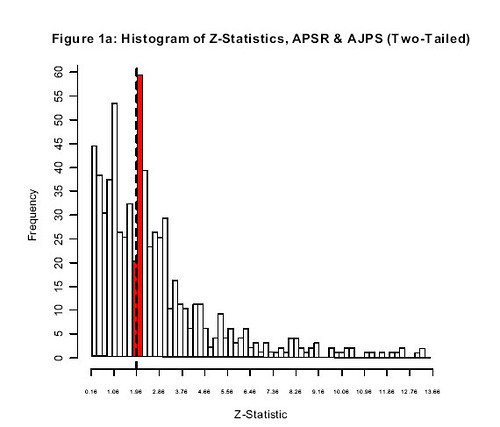A recent post relates to an issue that that should be familar to all applied econometricans - the magic 1.96 t-stat for statistical significance and the bias in economics against publishing "non-results". We have (possibly) fallen foul of this bias in the past.
This is an age old problem but it is worth highlighting again. Note that the post below relates to political science which of course is different to economics - is one group more honest that the other? Do econometric techniques differ greatly?
Below is the post in full. We have blogrolled "Trade Diversion".
1.96 is the magic number
---------------------------------------------------------------
Deirdre McCloskey has long emphasized the warping effects of the "statistical significance" hurdle to publication in economics. Alan Gerber and Neil Malhotra survey the top two journals in political science to produce this finding:

There are plenty of publications with findings that are barely statistically significant and a noticeable absence of papers that fall just short of the goalline. Figure 2a is more damning.
What's the implication? Andrew Gelman thinks it shows why hypothesis testing is problematic. Kevin Drum says it demonstrates massaging of data. The authors say:
The goal of this paper is to raise awareness of publication bias in political science. We have found that many more results are published just over the p=.05 threshold than below it, implying a certain amount of bias in parameter estimates. Our results suggest that as reviewers, editors, and researchers, political scientists appear to be far too conscious of the .05 significance level, and that this might cause important distortions in how knowledge advances in political science.
Full paper here.
2 comments:
nice post
__________________________________
Adobe Acrobat 9 Pro Extended oem
cheap Microsoft Visual Studio 2005 Professional Edition download
Adobe Acrobat 9 Pro Extended Cheap
Microsoft Office 2007 Enterprise Cheap
discount Microsoft Office 2003 Professional with Business Contact Manager for Outlook
discount Microsoft Windows Vista Ultimate
Microsoft Windows Vista Business Price
Acheter du cipro en Pharmacie
Comprare zithromax Online
Comprar kamagra Internet
Comprare kamagra Online
Prix accutane France
Comprare vermox Online
kamagra oral jelly Online Rezeptfrei
Acheter strattera France
Comprare accutane Online
Comprare imitrex Farmacia
Acheter lasix France
Post a Comment